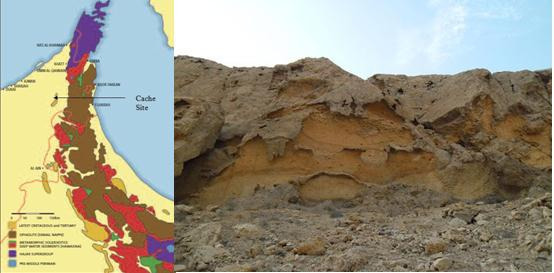
Finding seashell fossils embedded in the rocks in the middle of the UAE clearly proves that the area used to be the bottom of the sea a few millions of years ago. With the apparent ease of finding so many fossils just lying around also points to why the region is so rich in oil.
Formation of Oil
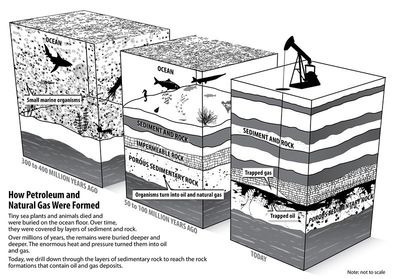 Crude oil is formed from the decayed remnants of aquatic plants and animals that lived hundreds of millions of years ago. Large portions of the modern day Middle East was once submerged under a large, now non-existent sea called the Tethys Sea. (250million to 65 million years ago) This sea eventually disappeared, sealing large deposits of organic matter under a salty crust. Over the eons, this crust was in turn covered by layer upon layer of sediment. As the sediment was compressed under the increasing weight of the layers above, it hardened into limestone. About 15-25 million years ago, the shifting of tectonic plates of the region formed large, underground fissures. As the organic matter migrated through the layers of limestone, much of the organic matter seeped into these fissures breaking down further by heat and pressure becoming crude and gas. The UAE coast rose above sea level in the late Miocene/early Pliocene (5 to 2 million years ago) and the Arabian Gulf filled with water again about 4 million years ago. Fossil evidence shows that in the late Miocene there were lush valleys to the west of Abu Dhabi
Crude oil is formed from the decayed remnants of aquatic plants and animals that lived hundreds of millions of years ago. Large portions of the modern day Middle East was once submerged under a large, now non-existent sea called the Tethys Sea. (250million to 65 million years ago) This sea eventually disappeared, sealing large deposits of organic matter under a salty crust. Over the eons, this crust was in turn covered by layer upon layer of sediment. As the sediment was compressed under the increasing weight of the layers above, it hardened into limestone. About 15-25 million years ago, the shifting of tectonic plates of the region formed large, underground fissures. As the organic matter migrated through the layers of limestone, much of the organic matter seeped into these fissures breaking down further by heat and pressure becoming crude and gas. The UAE coast rose above sea level in the late Miocene/early Pliocene (5 to 2 million years ago) and the Arabian Gulf filled with water again about 4 million years ago. Fossil evidence shows that in the late Miocene there were lush valleys to the west of Abu Dhabi
The Cache site:
Leave the tar at the entrance to the Jebel Al Bahais Archaeological site then follow the fence to the right and enter the area through the camel gate. (GPS cords provided) The route does not specifically require a 4×4 vehicle but a vehicle with good ground clearance is advisable as the entire escarpment is worth exploring.
Once leaving your car, keep your eyes pealed as there is plenty to see from different coloured rocks to fossils. Be sure to wear good walking shoes or hiking boots as the climbing to the base of the cliff can be quite slippery.
What can I see at the Cache Site?.
Apart from some excellent examples of Conglomerate rocks and there are outcrops of Brick Red Sandstone and Reperite. Marine fossils such as Bivalves, sea urchins, gastropods coral and Gypsum crystals can also be found.
Examples of some of the rock formations that can be seen at the Cache site
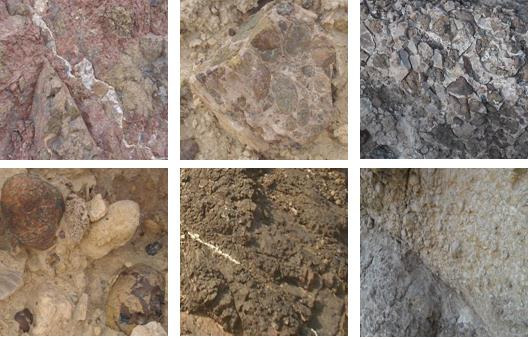 Conglomerate rocks are sedimentary rocks. They are made up of large sediments like sand and pebbles. The sediment is so large that pressure alone cannot hold the rock together; it is also cemented together with dissolved minerals. also classified by the dominant clast size.
Conglomerate rocks are sedimentary rocks. They are made up of large sediments like sand and pebbles. The sediment is so large that pressure alone cannot hold the rock together; it is also cemented together with dissolved minerals. also classified by the dominant clast size.
• Granule conglomerate 2–4 mm
• Pebble conglomerate 4–64 mm
• Cobble conglomerate 64–256 mm
• Boulder conglomerate >256 mm
Examples of some of the Fossils that can be found. This including the gastropods Acteonnellid
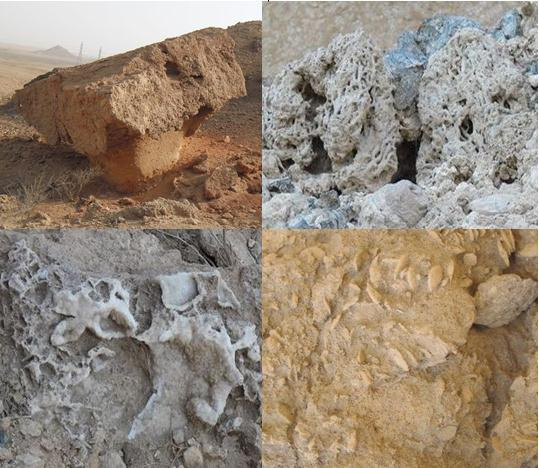
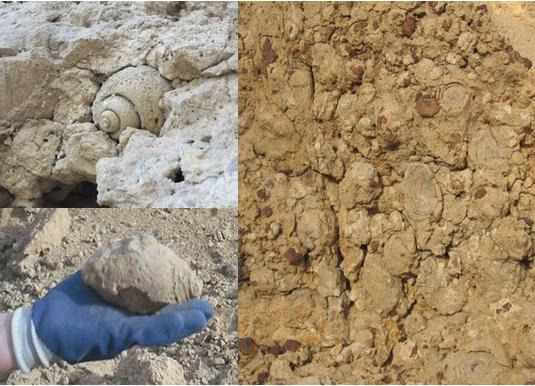
To claim this cache you need to email the cache owner the answers to the following questions
1. Estimate the distance from the GZ to either the coast line at Kalba in the East (90°) or Jebil Ali in the West (270°) and determine how and why these marine fossils are so far away from today’s shore line?
2. In your own words how were the fossils at the GZ formed?
3. Looking at the Conglomerates rocks at the GZ, what Clast size would they fall into?
4. (Optional)Take a photo at the GZ of any fossil including your GPS in the picture and add to your log
References:
1. http://www.alshindagah.com/Shindagah75/a_peak_into_the_past.htm
2. http://www.alshindagah.com/marapr2006/fossils.html
3. A special thanks to Paolo Rossetti, a 4x4 friend who runs the website http://weekenduae.com who provided me the information and the site coordinates.
4. All photographs taken by Geocachers Avanclan
